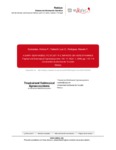Por favor, use este identificador para citar o enlazar este ítem:
http://www.alice.cnptia.embrapa.br/alice/handle/doc/939897| Título: | A dairy goat model to study the impacts on herd dynamics. |
| Autoria: | GUIMARÃES, V. P.  TEDESCHI, L. O.   RODRIGUES, M. T.   |
| Afiliação: | Vinícius P. Guimarães, Consultor da Embrapa Caprinos e Ovinos (CNPC).; Luis O. Tedeschi, Texas A&M University; Marcelo T. Rodrigues, Federal University of Viçosa (UFV) - Viçosa, MG. |
| Ano de publicação: | 2009 |
| Referência: | Tropical and Subtropical Agroecosystems, v. 11, n. 1, p. 115-119, 2009. |
| Conteúdo: | The understanding of a dairy goat production system is crucial to establish a more competitive activity. Therefore, a simulation model was built to evaluate the dynamics of dairy goat herd under different scenarios of production. A System Dynamics approach was used to identify management policies that affect the behavior of the herd. All parameters considered in this model assumed average values reported in production systems in the Southeast region of Brazil. To simulate a herd in dynamic equilibrium, the culling and retention rates were used. Thereafter, simulations were performed based on changes in reproductive and mortality rates. All the simulations were planned to take the variation in herd development based on simple management strategies over 10 years of simulation. The dynamic equilibrium of 50 lactating does was obtained when fixed culling and retention rates of 20 and 70%, respectively, were assigned to the does after 36 months of simulation. A sensitivity analysis was made and indicated that an increase of 20% in the reproduction rates increased the number of animals in the herd in 56%. A decrease in the reproduction rate of 20% reduced the number of animals in 43%. A third simulation indicated that increasing mortality rate from 4 to 10% of the female kids decreased the number of lactating does by 36%. These results indicated that small changes in reproduction and mortality rates can considerably affect the dynamics of the herd, even though the herd may not be immediately affected because of the intrinsic delays in the system. This result is extremely important to justify the need of activity planning to consider the gap between a measurement taken and the consequences, preparing the producers to potential delays in the system. The use of mathematical models is important to understand the relationships between variables and the dynamic of the system and to assist in applying best management strategies to enhance productivity of dairy goats. [Modelo de cabras lecheras para evaluar el impacto de las estrategias de manejo en la dinámica del rebaño]. |
| Thesagro: | Cabra leiteira Sistema de produção Melhoramento genético animal |
| NAL Thesaurus: | Goats Models Breeding Brazil |
| Palavras-chave: | Região Sudeste Brasil Production Modelo animal |
| Tipo do material: | Artigo de periódico |
| Acesso: | openAccess |
| Aparece nas coleções: | Nota Técnica/Nota científica (CNPC)  |
Arquivos associados a este item:
| Arquivo | Descrição | Tamanho | Formato | |
|---|---|---|---|---|
| NTAdairygoatmodel.pdf | 161,65 kB | Adobe PDF |  Visualizar/Abrir |









